There are 25 million creative professionals and most of them are likely using Macs with Intel (INTC) processors. The industry-standard software used by creative professionals are still x86-dependent. This is a quantifying reason why Apple (AAPL) is highly unlikely to replace Intel x86 processors like what Bloomberg reported earlier this week. Sad but true, Bloomberg merely regurgitated an old 2015 rumor.
It is more believable that Apple is making new co-processors for more Mac OS X computer products. There is little financial incentive to drop Intel processors on Macs. A BofA Merrill Lynch analyst, Wamsi Mohan, said Apple can save $40 to $50 if it uses its own in-house Mac processors. That translates to an annual savings of only $500 million. A savings of $500 million is insignificant to Apple. Apple’s latest annual net income was $48.35 billion.
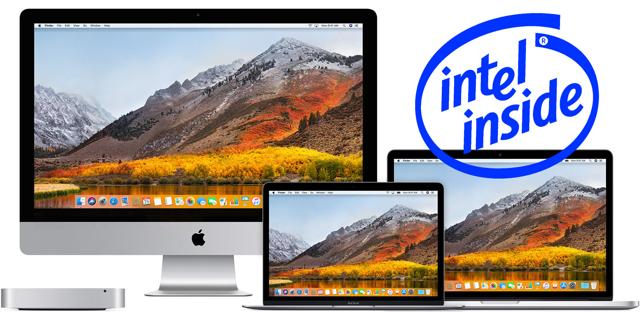
(Source: Apple/Intel)
Apple is not going to risk alienating Mac-using creative/business professionals for just $500 million in annual savings. Apple’s decision to switch to Intel processors in 2006 coincided with substantial annual growth in Mac sales. Mac sales from 2006 to 2017 almost quadrupled.
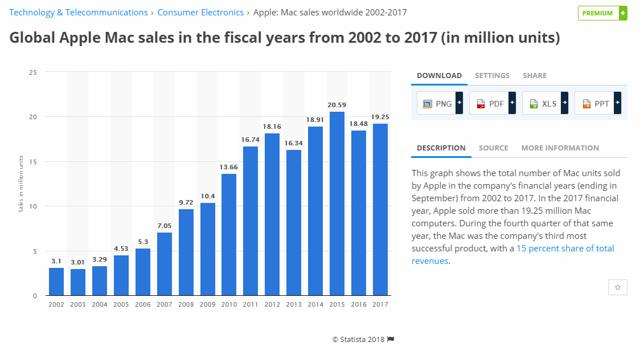
(Source: Statista)
We, the graphic artists, 3D modelers/animators, video editors and compositors found out that an Intel CPU coupled with Apple’s more CPU/RAM-efficient Mac OS is great for Photoshop and AutoCAD. It was a persistent problem that Adobe (ADBE) kept releasing its industry-standard software products with constantly increasing compute load from the CPU and RAM.
The Mac Would Have Died Without Intel’s Help
Intel played as the white knight and savior to Apple’s weak Mac business in 2005. Intel delivered Apple’s requirement for cost-efficient but more powerful desktop processors. The PowerPC CPU design of International Business Machines (IBM) was not able to keep up with the advancements of Intel’s x86 processors. IBM and Motorola did not have the factories to match Intel’s economy of scale.
The much smaller market share of the Mac compared to Windows PC sales is why IBM and Motorola found the PowerPC supply deal a money-losing venture. Back in the 90s/early 2000s, Macs were greatly outsold by Windows PCs with Intel processors. IBM and Motorola didn’t want to play patsy for Apple. Apple’s penny-pinching attitude was also discouraging IBM/Motorola to throw more money on the financial sinkhole called the PowerPC Mac CPU.
Steve Jobs realized that IBM/Motorola’s hesitance to allocate large amount for R&D meant the PowerPC Mac was headed for obsolescence. The already few number of Mac OS software developers would have gradually abandoned the stagnating PowerPC Mac.
Thanks to the unwillingness of IBM and Motorola to invest in their unprofitable RISC-based PowerPC design, Intel’s CISC-based x86 CPU hardware architecture became the go-to framework for forward-looking software developers. The CISC (Complex Instruction Set Computing) processor architecture consumes more electricity than RISC (Reduced Instruction Set Computing). However, CISC allows for more advanced features, more complex software programming. RISC’s core advantage is only in power efficiency. CISC’s purpose is to continuously improve hardware design to achieve better performance.
Compare Photoshop CS 2 versus Photoshop CC 2018. Back in 2006, Photoshop CS 2 was only for photo editing/compositing. The latest Photoshop CC 2018 has Artificial Intelligence and GPU hardware acceleration. Photoshop can do app prototyping, website design, UI/UX design, video clip editing, and animation. The more usable features of current design software products are definitely thanks to the advances in the x86 processor designs of Intel and Advanced Micro Devices (AMD).
More Reasons Why The Mac Is A Captured Customer of Intel
Apple certainly has the financial might to develop its own Mac OS X processor. However, Intel is unlikely to give Apple a full x86 license. It would be like Intel shooting itself in the kneecap. Sad but true, Apple can develop more powerful ARM-based processors and they will still be useless when it comes to running legacy x86 Mac software. Apple itself has yet to port 1:1 iOS conversions of its own popular Mac software products like Final Cut Pro (video editing software) and Logic Pro X (digital music workstation software). We should not expect Maxon, Adobe, or Autodesk (ADSK) to be able to convert their x86 Mac apps to run natively on Apple’s A-series of ARM-based processors.
Years ago it was easy to run legacy PowerPC software on CISC-based Intel Macs via Apple’s Rosetta emulation layer. This was because RISC-based PowerPC apps are much like lightweight apps written for the ARM-based platforms of iOS and Android. Unlike RISC or ARM-based processors, any Intel processor with its built-in Virtualization Technology enabled can run any OS and software.
Evidence of this is there are hundreds of dual-booting Windows/Android tablets for sale. If you have an Intel Mac, download Apple’s Xcode IDE and you can emulate iOS games/apps. If your Intel Windows PC has 8GB of RAM or more, you can download VirtualBox and run a virtual macOS Sierra with Xcode to emulate iOS apps.
It is a cakewalk for ARM-based apps to run natively on x86 processors. It is nearly impossible for legacy win32 x86 apps to run natively on ARM-based/RISC processors. Evidence? If it was possible, all the industry standard Mac software would have 1:1 ported versions running on iPads now.
This is the unique capability of Intel/AMD x86 processors. They are compatible with almost any operating systems and software programs. I hope Bloomberg will understand now that Apple’s Marzipan project to let iOS apps run on Mac computers doesn’t mean Apple will use in-house CPUs for its Mac products. Apple is copying the original idea of Google (GOOG) (NASDAQ:GOOGL) to let Android apps run on Chrome OS computers. Most Chromebooks run on x86 Intel processors. I do not think Apple has the cloud infrastructure to copy Google’s streaming apps platform too.
My takeaway is Project Marzipan is just Apple’s macOS-embedded version of several Android emulators available for Windows computers. If iOS isn’t closed-sourced and Apple so possessive of its IP, it will be easy even for freelance software engineers to create iOS emulators for Intel-based Windows and macOS computers.
Apple Will Not Repeat Microsoft’s Desperate Windows 10 ARM Experiment
Apple is too clever to repeat Microsoft's (NASDAQ:MSFT) quixotic idea of Universal Windows Platform. Not many developers wasted their time making UWP-compliant versions of their legacy win32 x86 software just to heed Microsoft's call to have Windows run on x86 and Windows ARM devices.
Microsoft is also unlikely to release its popular desktop Office productivity software for an ARM-based Mac computer. Microsoft has its own Surface products to protect. I was never optimistic about the commercial viability of Windows 10 on ARM. However, Windows 10 on ARM is a feat that Apple has yet to replicate. Mac OS X High Sierra is still only compatible with x86.
Mac loyalists aren’t going to be happy if Apple commits the same mistake of Microsoft implementing Windows 10 on ARM. The atrocious performance of x86 software emulation on Hewlett-Packard’s (HPQ) $999 Snapdragon 835 Windows 10 laptop is prima facie evidence that Apple is unlikely to do legacy x86 software emulation using ARM-based Macs.
The charts below are from TechSpot’s real-world tests of x86 software emulation on Windows 10 ARM. The Octa-core Snapdragon 835 is Qualcomm’s flagship processor last year. It miserably failed to deliver Microsoft’s promise of near-native performance of x86 app emulation.
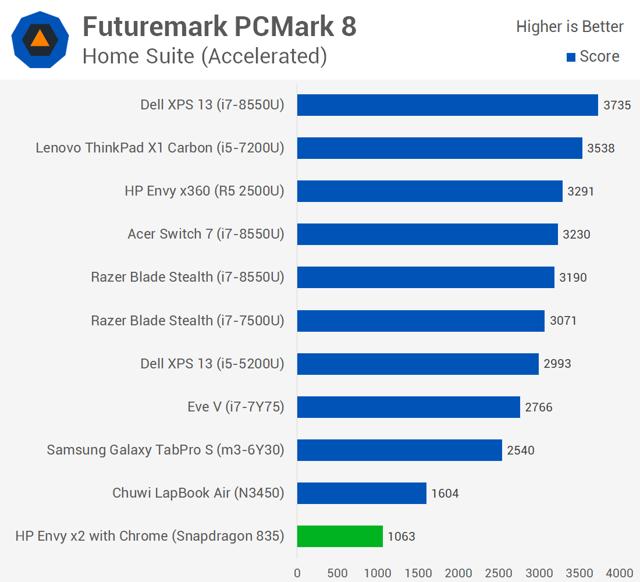
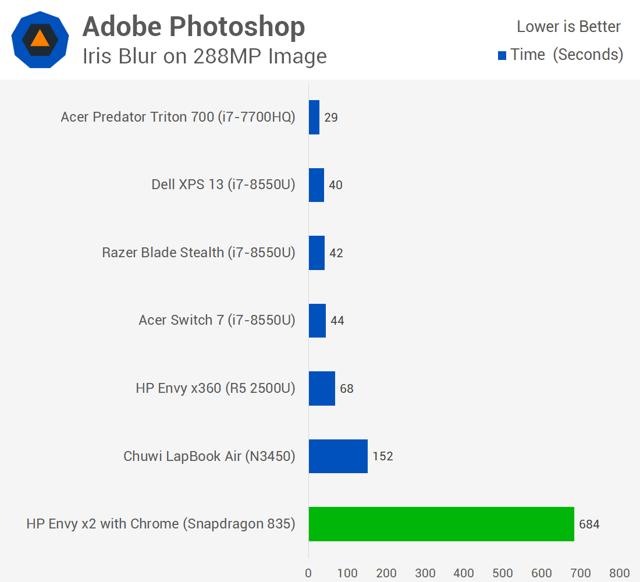
(Source: TechSpot)
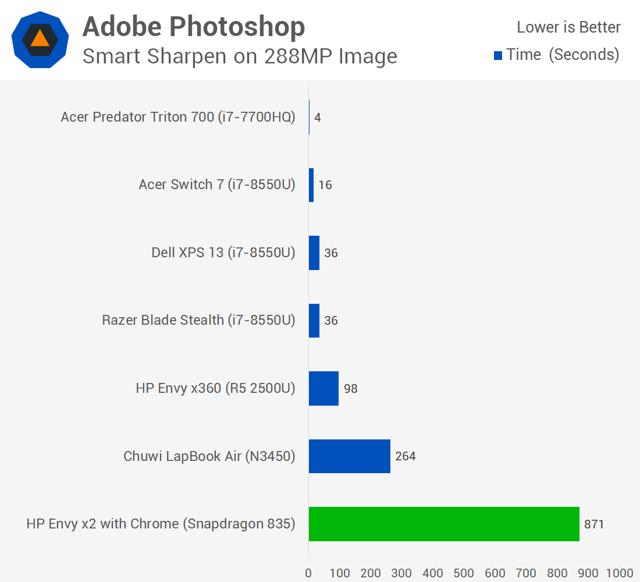
(Source: TechSpot)
Conclusion
I hope this long article convinced investors that Bloomberg is wrong to assume Mac computers will start using in-house Apple processors by 2020. I believe Apple’s management team is still sticking to the highly-lucrative ‘product differentiation’ approach to its premium consumer products. Apple squeezes more money out its millions of loyal customers by selling them single-function devices. The idea of combining the MacBook/iPad into one single product is anathema to Apple shareholders.
Apple never released a touchscreen MacBook to counter Microsoft’s 2-in-1 Windows 10 Surface laptops. Apple is the smarter hardware vendor than Microsoft. It makes much more money selling Intel-based MacBooks with no touchscreen displays. This compels Mac-dependent artists (envious of Surface users) to buy expensive iPad Pros and the $99 Pencil accessory.
I am long INTC. I bet $1,000 that come 2020, Macs will still use Intel processors, AMD GPUs, and Apple made co-processors. Thanks to the Virtualization Technology of Intel's processors, Project Marzipan will allow iOS apps to run on macOS computers.
Lastly, Apple only sold 20 million Macs last year. I have no evidence, but guesstimating an average price of $150 per processor supplied (Apple is still penny-pinching), Apple is only contributing $3 billion to Intel's topline. Intel's FY 2018 revenue was $62.8 billion. Although it is unlikely that Macs will drop x86 processors, Intel doesn't really need the Mac business to prosper.
On the other hand, Mac sales will likely decline if they use ARM-based Apple-designed processors.
Disclosure: I am/we are long INTC, AAPL, MSFT, AMD, GOOG.
I wrote this article myself, and it expresses my own opinions. I am not receiving compensation for it (other than from Seeking Alpha). I have no business relationship with any company whose stock is mentioned in this article.



No comments:
Post a Comment